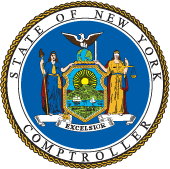Millions of Americans still face housing insecurity as a result of the COVID-19 pandemic, with nearly 15 percent behind on rent payments at the end of June. New York City not only houses the majority of the State’s renters but also had relatively high rates of rent-burdened tenants prior to the pandemic.
Reports
See Audits to search for audits related to State agencies, NYC agencies, local governments, school districts and public authorities.
August 2021 —
On June 30, 2021, New York City adopted its $98.7 billion budget for fiscal year 2022. Excluding federal aid, the City will fund about $2 billion more in spending than was planned in its proposed executive budget in April, after adjusting for surplus transfers and money set aside for reserves.
June 2021 —
One year after COVID-19 caused the sharpest economic contraction on record and exposed New York City’s finances to substantial risks, the City’s economy and finances are on the mend, thanks largely to unprecedented federal economic stimulus for businesses and individuals, and direct federal relief to New York State, New York City and the Metropolitan Transportation Authority.
June 2021 —
Population in the Bronx grew by 10.4 percent from 2000 to 2017 (faster than any other borough), driven primarily by the growth in the immigrant population, but it declined in the next two years to 1.42 million residents.
June 2021 —
The COVID-19 pandemic brought a halt to the growth of the construction industry nationwide which, prior to the pandemic, had been growing strongly. This was especially true in New York State and New York City.
April 2021 —
In 2020, the 10-year period of record growth in tourism came to an end, and the number of visitors to New York City fell by 67 percent to 22.3 million (from 66.6 million in 2019). OSC estimates the industry’s economic impact dropped by 75 percent from $80.3 billion in 2019 to $20.2 billion in 2020.
April 2021 —
The MTA’s capital program for 2020-2024 totals $54.8 billion, by far the largest program in its history. As of December 31, 2020, only 100 of 517 projects had been completed or begun, and most of the rest of the program had been indefinitely suspended.
March 2021 —
The average bonus paid to employees in New York City’s securities industry grew by 10 percent in 2020 to $184,000, in line with the city’s most recent 9.9 percent projection, likely allowing the city to meet or exceed its income tax revenue projections in FY2021.
March 2021 —
Comptroller DiNapoli has launched an interactive online tool of subway ridership that details where straphangers are, and are not, returning to the subway system, alongside neighborhood and local demographics, employment and income.
February 2021 —
As of December 2020, arts, entertainment and recreation employment declined by 66 percent from one year earlier, the largest decline among the City’s economic sectors.
February 2021 —
The COVID-19 pandemic ended a period of economic expansion in New York City during which new records for population, tourism, employment, and property values were achieved. As a result, City revenues grew rapidly from FY 2010 to FY 2019, enabling City spending to grow by 55 percent, nearly four times the rate of inflation, and provide a budget cushion of more than 10 percent of City-funded revenues at the start of FY 2020.
February 2021 —
Although New York City was an early epicenter for COVID-19, only 45.6 percent of firms in the City received Paycheck Protection Program (PPP) loans, below the national average of 50.9 percent.
December 2020 —
The economic, social and budgetary fallout from the COVID-19 pandemic in New York City has been unprecedented, while the loss of life has been unimaginable. As we enter 2021, the pandemic remains a threat to our health and economy as we face rising case and hospitalization figures as well as renewed restrictions to manage the public health risks.
December 2020 —
The COVID-19 pandemic has affected the retail trade sector unevenly, with online retailers and some essential businesses experiencing growth and other large retail segments seeing falling revenues. The impact has been most obvious in Manhattan, where foot traffic in key corridors initially fell by more than 90 percent and remains below 50 percent of its 2019 levels as tourists, commuters, office workers and residents have responded to pandemic-related shutdowns and public health concerns.
October 2020 —
The COVID-19 pandemic has created a fiscal emergency for the City of New York, creating significant revenue shortfalls and increased costs associated with managing the public health crisis.
October 2020 —
The COVID-19 pandemic has significantly impacted the securities industry in New York City, affecting both operations and profitability.
October 2020 —
The Metropolitan Transportation Authority (MTA) is facing the greatest challenge in its history.
October 2020 —
The restaurant industry is essential to New York City’s social and economic fabric. From small, family-owned restaurants and food carts to four-star world-famous establishments, the City abounds with restaurants that offer cuisines from every corner of the globe.
September 2020 —
In March and April 2020, Congress passed four stimulus bills to address the COVID-19 pandemic’s impact on the public health system and the economy. As Congress debates additional relief measures, it is worth reviewing the targeting of the initial funding in order to inform new policy to counter the virus and its economic effects.
August 2020 —
The economic, social and budgetary fallout from the COVID-19 pandemic on New York City has been unprecedented, while the loss of life has been unimaginable. Restrictions put in place to slow the spread of the disease triggered a national recession. In New York City, job losses in March and April were the largest since the Great Depression.
